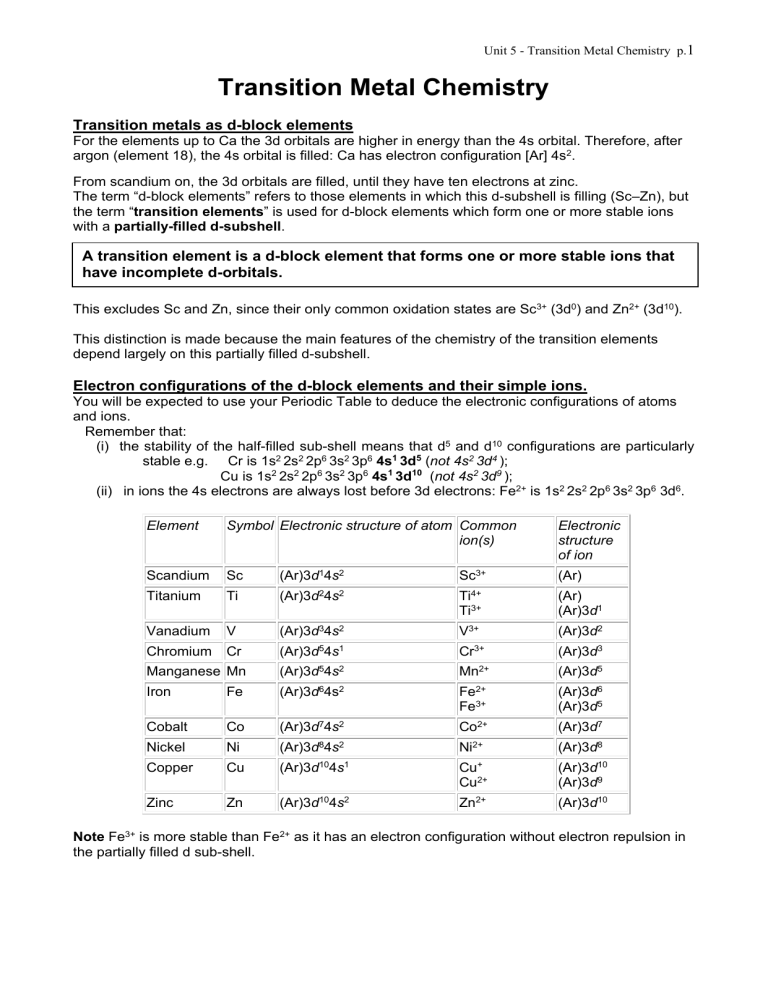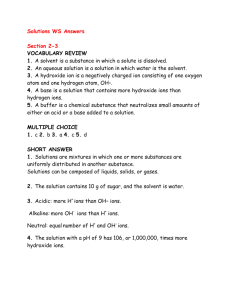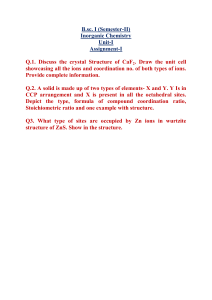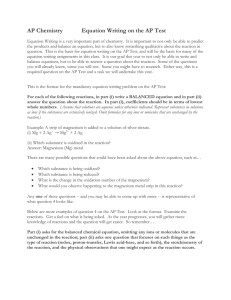
Unit 5 - Transition Metal Chemistry p.1 Transition Metal Chemistry Transition metals as d-block elements For the elements up to Ca the 3d orbitals are higher in energy than the 4s orbital. Therefore, after argon (element 18), the 4s orbital is filled: Ca has electron configuration [Ar] 4s2. From scandium on, the 3d orbitals are filled, until they have ten electrons at zinc. The term “d-block elements” refers to those elements in which this d-subshell is filling (Sc–Zn), but the term “transition elements” is used for d-block elements which form one or more stable ions with a partially-filled d-subshell. A transition element is a d-block element that forms one or more stable ions that have incomplete d-orbitals. This excludes Sc and Zn, since their only common oxidation states are Sc3+ (3d0) and Zn2+ (3d10). This distinction is made because the main features of the chemistry of the transition elements depend largely on this partially filled d-subshell. Electron configurations of the d-block elements and their simple ions. You will be expected to use your Periodic Table to deduce the electronic configurations of atoms and ions. Remember that: (i) the stability of the half-filled sub-shell means that d5 and d10 configurations are particularly stable e.g. Cr is 1s2 2s2 2p6 3s2 3p6 4s1 3d5 (not 4s2 3d4 ); Cu is 1s2 2s2 2p6 3s2 3p6 4s1 3d10 (not 4s2 3d9 ); (ii) in ions the 4s electrons are always lost before 3d electrons: Fe2+ is 1s2 2s2 2p6 3s2 3p6 3d6. Element Symbol Electronic structure of atom Common ion(s) Electronic structure of ion Scandium Sc (Ar)3d14s2 Sc3+ (Ar) Titanium Ti (Ar)3d24s2 Ti4+ Ti3+ (Ar) (Ar)3d1 Vanadium V (Ar)3d34s2 V3+ (Ar)3d2 Chromium Cr (Ar)3d54s1 Cr3+ (Ar)3d3 Manganese Mn (Ar)3d54s2 Mn2+ (Ar)3d5 Iron Fe (Ar)3d64s2 Fe2+ Fe3+ (Ar)3d6 (Ar)3d5 Cobalt Co (Ar)3d74s2 Co2+ (Ar)3d7 Nickel Ni (Ar)3d84s2 Ni2+ (Ar)3d8 Copper Cu (Ar)3d104s1 Cu+ Cu2+ (Ar)3d10 (Ar)3d9 Zinc Zn (Ar)3d104s2 Zn2+ (Ar)3d10 Note Fe3+ is more stable than Fe2+ as it has an electron configuration without electron repulsion in the partially filled d sub-shell. Unit 5 - Transition Metal Chemistry p.2 General Properties of Transition Metals. Transition metals have higher melting points, higher boiling points and higher densities than other metals. Transition metals also show the following characteristic properties: 1. Variable oxidation states:- Transition metals have electrons of similar energy in both the 3d and 4s levels. This means that one particular element can form ions of roughly the same stability by losing different numbers of electrons. Thus, all transition metals from titanium to copper can exhibit two or more oxidation states in their compounds. Oxidation states of some Transition Metals: Titanium- +2, +3, +4 Chromium- +2, +3, +6 Iron- +2, +3 Nickel- +2, +3, +4 Vanadium- +2, +3, +4, +5 Manganese- +2, +3, +4, +5, +6, +7 Cobalt- +2, +3 Copper- +1, +2 2. Formation of complex ions:- As a lot of the transition metals have some empty spaces in their 3d-orbitals, they can receive lone pairs of electrons and form dative covalent bonds thus producing complex compounds. 3. Coloured compounds:- When electrons move from a d-orbital (with lower energy) to another dorbital (with higher energy), energy is taken in. This energy is in the form of visible light. The transition metal appears the complementary colour to the ight absorbed, thus producing coloured compounds. 4. Catalytic properties:- For any element its higher oxidation states give rise to covalent compound formation. As Transition Metals have variable oxidation states, they tend to have catalytic properties. Complex ions Water molecules, hydroxide ions, ammonia molecules and cyanide ions can all link on to transition metal ions to form complex ions. They do so by donating a lone pair to form a bond – this is a dative covalent bond. The ions or molecules that form these bonds are called ligands. A complex ion is one in which a central positive ion is surrounded by ligands, which are coordinately (datively) bonded to it; e.g. Cr(H 2 O) 6 3+, Fe(CN) 6 4–. A ligand is a molecule or negative ion which has a lone pair of electrons, and can use its lone pair to form co-ordinate bonds to a metal ion; e.g. H 2 O, CN–. The transition metals are not unique in forming complexes (there are small numbers formed by metals in groups 2, 3 and 4), but they form a much wider range than other elements. This is because the transition metal ions are small and polarising, since their nuclei are poorly shielded, and so they attract ligands strongly. Unit 5 - Transition Metal Chemistry p.3 Naming Complex Ions The names of complex ions contain four main components. First part Second part Third part Number of each Name of ligand Name of transition metal (ending in – type ligand ate if it is a negative ion) Ion formula [Cu(H 2 O) 6 ]2+ [Cr(H 2 O) 6 ]3+ [CuCl 4 ]2[Cu(NH 3 ) 4 ]2+ [Fe(CN) 6 ]4- Fourth part Charge on transition metal Name of ion hexaaquacopper(II) hexaaquachromium(II) Tetrachlorocuprate(II) tetraamminecopper(II) hexacyanoferrate(II) When writing formulae, the central atom is put first, then the negative ions and then follow any neutral molecules. Everything is then put in square brackets and the charge added. For example, tetraaquachloro copper (II) would be written as [CuCl(H 2 O) 4 ]+ Shapes of Complex Ions Complex ions can be tetrahedral in shape, but the majority have an octahedral shape. Linear Dichlorocuprate(I) [CuCl 2 ]- ClTetrahedral Cu+ Cl- Tetrachlorochromate(III), [CrCl 4 ]- ClCr3 Cl Cl Cl Planar Dichlorodiamminoplatinum(II), [Pt(NH 3 ) 2 Cl 2 ] NH3 Cl Pt2+ Cl Octahedral NH3 Hexaaquacopper(II), [Cu(H 2 O) 6 ]2+ Hexaamminechromium(III), [Cr(NH 3 ) 6 ]3+ NH3 H2O OH2 H2O Cu2+ H2O Cr OH2 H2O NH3 H3N 3+ H3N NH3 NH3 Unit 5 - Transition Metal Chemistry p.4 Bidentate and Polydentate ligands All the above complexes contain monodentate ligands (ligands that have one set of teeth wih which they bite onto the transition metal ion) as they form one dative covalent bond. Other ligands can form more than one dative bond and are called polydentate. An example of a polydentate ligand is 1,2-diaminoethane; this is can form two dative bonds so can also be referred to bidentate. CH2 CH2 H2N NH2 H2C H2N H2C H2N Ni 2+ NH2 H2N CH2 CH2 Another polydentate ligand is called by letters which come from the old name of the ethylenediaminetetraacetate, or EDTA. O O CH2C CCH2 OO- - O O N-CH2-CH2-N CCH2 CH2C O This can form six dative bonds so is a hexadentate ligand. O Colour in Complex Ions When ligands pack around a metal ion, the d-orbitals no longer have exactly the same energies. If they are partially filled, it is possible for an electron to jump from a lower-energy d-orbital to an unoccupied higher-energy d-orbital. These “d–d transitions” are of an energy corresponding to absorption in the visible region, and so the compound appears to be coloured. The colour is that of the light which is not absorbed: e.g. copper(II) ions look blue because they absorb red light. The energies of d-orbitals, and so the colour of the complex, are very sensitive to the ligand present. Visible light stretches from purple/blue at 400–500nm, via yellow at around 600nm to red at 650nm. A complex absorbing from 400–550nm will look red (like Fe(H 2 O) 5 SCN2+ below) while one absorbing from 600-650nm will look blue (e.g. Cu(H 2 O) 6 2+). One absorbing in the middle, from 500-600nm will be a blue/red mix i.e. purple. Compounds of d-block elements which are not transition elements cannot undergo these electron transitions, so do not have coloured compounds. The compounds of zinc and scandium are therefore white and colourless in solution. Copper(I) which has a full d-shell also has white compounds. Unit 5 - Transition Metal Chemistry p.5 Ligand Exchange Processes It is possible for one type of ligand to be replaced by another type. Ligand exchange reactions often have a colour change associated with them. Thiocyanate ions can replace one of the water ligands in [Fe(H 2 O) 6 ]3+. [Fe(H 2 O) 6 ]3+ + SCN- → [Fe (H 2 O) 5 SCN]2+ + H 2 O An aqueous Copper(II) sulphate solution is blue in colour because of the presence of [Cu(H 2 O) 6 ]2 ions. When concentrated hydrochloric acid is added to this solution the colour changes from blue to green. This happens because the [CuCl 4 ]2- ion is produced. The Cl- ions have replaced the H 2 O molecules in a ligand exchange. [Cu(H 2 O) 6 ]2+ + 4Cl- → [CuCl 4 ]2- + 6H 2 O When ammonia is added a further change from green to deep blue takes place as ammonia molecules replace the chloride ions. [CuCl 4 ]2- + 4NH 3 + 2H 2 O → [Cu(NH 3 ) 4 (H 2 O) 2 ]2+ + 4ClIf EDTA is then added yet another ligand exchange takes place and the solution turns pale blue. [Cu(NH 3 ) 4 (H 2 O) 2 ]2+ + edta → [Cu(edta)]2+ + 4NH 3 + 2H 2 O These changes take place because the complexes become more stable. [Cu(H2O)6]2+ [CuCl4]2- [Cu(NH3)4(H2O)2]2+ [Cu(edta)]2+ Increasing stability The stability of the [Cu(edta)]2+ complex can be understood in terms of entropy. As the one edta molecule replaces the six smaller ligands, the small ligands are released into solution and therefore have greater freedom of movement, so greater disorder and consequently the entropy increases. Unit 5 - Transition Metal Chemistry p.6 Oxidation states of transition elements – Cu and Cr Copper [Ar]3d104s1 Copper, 3d10, is the only member of the transition series to have a significant +1 oxidation state, and even here the +1 state is only stable if in a complex ion, or in an insoluble compound – in solution, it disproportionates. The +1 state, with a full d sub-shell, is not coloured (apart from Cu 2 O). The +2 state, with its familiar blue and green complexes, is the normal stable state. Cu(I) • • • Cu 2 O, as made by reduction of Fehling’s or Benedict’s solution with a reducing sugar, is a red insoluble solid. CuCl and Cu 2 SO 4 are white solids. Both of these, when dissolved in water disproportionate: 2Cu+(aq) Cu(s) + Cu2+(aq) This can be understood in terms of the redox potentials: Cu+ Eo = +0.15V Cu2+ + e+ Cu + eCu Eo = +0.52V There is a reaction between the two underlined species, i.e. the disproportionation. So when a copper(I) compound is dissolved in water a blue solution (Cu2+ (aq) ) and a redbrown solid (Cu (s) ) are formed. Cu(II) • • • Most copper(II) compounds are blue, and in solution they give blue Cu(H 2 O) 6 2+ ions. When copper(II) sulphate solution is treated with dilute aqueous ammonia, the solution starts blue because of the Cu(H 2 O) 6 2+ ion. It first forms a pale blue precipitate of Cu(OH) 2 , and then this dissolves to give a deep blue coloured solution, containing the Cu(NH 3 ) 4 (H 2 O) 2 2+ ion. [N.B. the hydroxide is formed first because ammonia solution is alkaline, due to the reaction NH 3 + H 2 O NH 4 + + OH – . Then the high concentration of NH 3 molecules displaces the equilibrium in favour of forming the ammonia complex.] Overall: Cu(H 2 O) 6 2+ + 4NH 3 Cu(NH 3 ) 4 (H 2 O) 2 2+ + 2H 2 O When copper(II) sulphate solution is treated with concentrated hydrochloric acid (or sodium chloride solution), the solution starts blue because of the Cu(H 2 O) 6 2+ ion. As Cl– ions are added they displace water molecules, forming the tetrahedral CuCl 4 2–, which is yellow. The colour changes from blue through lime-green to yellow-green, and becomes more intensely coloured despite the dilution: Cu(H 2 O) 6 2+ + 4Cl–(aq) CuCl 4 2– + 6H 2 O With sodium hydroxide Cu2+(aq) turns from a blue solution to give a mid/light-blue precipitate: Cu2+(aq) + 2OH–(aq) Cu(OH) 2 (s) Estimation of copper(II) Cu2+(aq) ions will react quantitatively with iodide ions, oxidising the latter to iodine and being reduced themselves to a white precipitate of copper(I) iodide: 2Cu2+(aq) + 4I–(aq) 2CuI(s) + I 2 (s) When excess potassium iodide solution is added, the blue colour disappears and a brown solution with a white precipitate results. This can be titrated with standard sodium thiosulphate, adding starch before the endpoint and continuing until the blue colour disappears (leaving the white S 4 O 6 2–(aq) + 2I–(aq) precipitate). I 2 (aq) + 2S 2 O 3 2–(aq) Unit 5 - Transition Metal Chemistry p.7 Chromium [Ar]3d54s1 Chromium has common oxidation states of 3+ and 6+, although 2+ also exists. Chromium (II) Cr2+ Chromium (III) Cr3+ Chromium (VI) Chromate CrO 4 2- Blue Green Yellow Dichromate Cr 2 O 7 2Orange Cr(II) • The Cr(H 2 O) 6 2+ ion is readily oxidised to Cr(H 2 O) 6 3+ Cr(III) • • • • The Cr(H 2 O) 6 3+ ion is purple, as are crystals of chromium(III) sulphate, Cr 2 (SO 4 ) 3 . Cr 2 O 3 is a green solid, and Cr(OH) 3 is obtained as a green precipitate by adding sodium hydroxide to any solution of a chromium(III) salt. It is amphoteric and dissolves in excess sodium hydroxide to form a green solution of Cr(OH) 6 3–. Hydrated chromium(III) chloride is a green solid, which gives a green solution with one or more Cl– ions in the aqua-complex e.g. Cr(H 2 O) 4 Cl 2 +. Cr3+(aq) can be oxidised to chromium(VI) by adding excess sodium hydroxide, then hydrogen peroxide, and boiling. The solution goes yellow as CrO 4 2– ions are formed. Cr(VI) • Potassium dichromate(VI), K 2 Cr 2 O 7 , is an orange solid which dissolves in water to give an orange solution. In alkali this changes to the yellow chromate(VI) ion, and back again to orange dichromate(VI) on acidification: 2CrO 4 2– + H 2 O then 2CrO 4 2– + 2H+ Cr 2 O 7 2– + H 2 O Cr 2 O 7 2– + 2OH– orange yellow yellow orange Note that this is not a redox reaction. • Potassium dichromate is a good primary volumetric standard (i.e. can be obtained pure and stable, so can be weighed out to give a solution of reliably known concentration), and is often used to titrate with iron(II) ions, using a redox indicator. Cr 2 O 7 2– + 14H+ + 6Fe2+ 2Cr3+ + 7H 2 O + 6Fe3+ • The EO value of +1.33V for Cr 2 O 7 2– in acid (to 2Cr3+) shows that it is quite a strong oxidising agent, and can be reduced by many moderate reducing agents (SO 2 , Sn2+, ethanol on warming), when it turns from orange to green. Uses of Cr Chromium metal is used in making stainless steel is much more expensive than mild steel, resists corrosion effectively, but lacks some other useful properties (e.g strength, hardness) and so cannot always be substituted for normal steel. Chromium is added to iron in smaller amounts to make alloy steels which are very hard (used for example in ball bearings). Unit 5 - Transition Metal Chemistry p.8 Deprotonation reactions Deprotonation reactions involve water ligands losing hydrogen ions (proton) to a proton acceptor such as an hydroxide ion. [Cu(H 2 O) 6 ]2+ + OH- [Cu(OH)(H 2 O) 5 ]+ + H 2 O Deprotonation reactions often result in the formation of a precipitate. Reaction of complex ions with sodium hydroxide and ammonia solutions Sodium hydroxide and ammonia solutions contain hydroxide ions. When these are added to solutions containing transition metal ions a precipitate of the metal hydroxide is formed. If further quantities of these reagents are added to the mixture, the precipitate, in certain cases, dissolves. Ion in solution Cr3+ Reaction with a few drops of NaOH (aq) or NH 3(aq) Pale green ppt Mn2+ Fe2+ Fe3+ Ni2+ Beige ppt Dirty green ppt Red-brown ppt Green gelatinous ppt Reaction with excess NaOH (aq) Ppt dissolves to form a deep green solution No further reaction No further reaction No further reaction No further reaction Cu2+ Blue ppt No further reaction Zn2+ White gelatinous ppt Ppt dissolves to form a colourless solution Reaction with excess NH 3(aq) No further reaction No further reaction Ppt dissolves to form a blue solution Ppt dissolves to form a deep blue solution A simple way of looking at these is as hydroxide ions adding to the transition metal ion – the number of hydroxide ions being equal to the charge on the ion. [M(H 2 O) x ]y+ + yOH- → [M(H 2 O) x-y (OH) y ] + yH 2 O In fact rather than a water molecule leaving and a hydroxide ion joining, the process actually consists of a hydrogen ion moving. H2O H2O H2O - OH OH2 Cu 2+ + H OH2 H2O H2O H+ OH- OH H2O Cu2+ H2O H2O H2O OH H2O This process is called a deprotonation reaction. All the reactions in which the transition ions form precipitates are deprotonation reactions. When the precipitates dissolve in excess sodium hydroxide solution, it is because a further deprotonation reaction takes place. These reactions represent a metal hydroxide reacting with an alkali, so it can be regarded as being due to the amphoteric nature of the metal hydroxide and reflects a degree of non-metal character. Unit 5 - Transition Metal Chemistry p.9 When the precipitate dissolves in excess ammonia solution, it is because the ammonia molecules replace the hydroxide and water molecules around the transition metal ion, and so this is a ligand replacement reaction. Transition metal solution Addition of sodium hydroxide or ammonia solution Proton transfer Precipitate forms Addition of sodium hydroxide solution Addition of ammonia solution Proton transfer Precipitate dissolves ion aqueous sodium hydroxide Cr3+ Cr3+ (aq) + 3OH- (aq) Cr(OH) 3(s) grey green Ligand exchange Precipitate dissolves aqueous ammonia solution Cr3+(aq) + 3OH-(aq) Cr(OH)3(s) grey green Cr(OH) 3 (H 2 O) 3(s) + 3OH- (aq) [Cr(OH)6]3-(aq) + 3H2O hexahydroxochromate(III) deprotonation Mn2+ Mn2+(aq) + 2OH-(aq) Mn(OH)2(s) white/brown Mn2+(aq) + 2OH-(aq) Mn(OH)2(s) white/brown Fe2+ Fe2+(aq) + 2OH-(aq) Fe(OH)2(s) muddy/green Fe2+(aq) + 2OH-(aq) Fe(OH)2(s) muddy/green Fe3+ Fe3+(aq) + 3OH-(aq) Fe(OH)3(s) rust brown Fe3+(aq) + 3OH-(aq) Fe(OH)3(s) rust brown Ni2+ Ni2+(aq) + 2OH-(aq) Ni(OH)2(s) lime green Ni2+(aq) + 2OH-(aq) Ni(OH)2(s) lime green ligand exchange - dissolves in excess to give blue [Ni(NH3)6]2+(aq) Cu2+ Cu2+(aq) + 2OH-(aq) Cu(OH)2(s) pale blue Cu2+(aq) + 2OH-(aq) Cu(OH)2(H2O)4(s) pale blue ligand exchange - dissolves in excess to give deep blue [Cu(NH3)4(H2O)2]2+(aq) Zn2+ Zn2+(aq) + 2OH-(aq) Zn(OH)2(s) white Zn(OH)2(s) + 2OH-(aq) [Zn(OH)4]2-(aq) deprotonation Zn2+(aq) + 2OH-(aq) Zn(OH)2(s) ligand exchange - dissolves in excess to give [Zn(NH3)4]2+(aq) Unit 5 - Transition Metal Chemistry p.10 Catalytic Properties of Transition Elements The ability of transition elements to change oxidation state allows them to be used as catalysts. Transition elements or their compounds are used in a number of important industrial processes. Substance Iron Nickel Vanadium(V) oxide Reaction catalysed Haber process to convert nitrogen and hydrogen to ammonia Margarine production to hydrogenate unsaturated hydrocarbons Contact process to convert oxygen and sulphur dioxide to sulphur trioxide There are two main types of catalysis. Heterogeneous catalysis is where the catalyst and the reactants are in different states. Homogeneous catalysis is where the catalyst and the reactants are in the same state. An example of heterogeneous catalysis is seen in the catalytic converters found in cars. Platinum is used to remove harmful gases such as carbon monoxide. 2CO + O2 → 2CO2 Platinum provides a surface with which the carbon monoxide and oxygen can forms weak bonds. The transition metal uses 3d and 4s electrons to form these bonds. The bonding of the molecules on the surface brings them close together and the formation of the weak bonds with the surface weakens the bonds within the molecules, reducing the energy required to break them. The ability of the transition element to change its oxidation state is also important in catalysis. This is seen in the manufacture of sulphuric acid where the conversion of sulphur dioxide to sulphur trioxide is catalysed by vanadium(V) oxide. 2SO3 2SO2 + O2 The sulphur dioxide first reacts with the vanadium(V) oxide. SO2(g) + V2O5(s) → SO3(g) + V2O4(s) The vanadium(IV) formed in this reaction then reacts with the oxygen ½O2(g) + V2O4(s) → V2O5(s) An example of homogeneous catalysis is seen in the catalysis by iron(II) of the reaction between the persulphate and iodide ions. S2O82- + 2I- → 2SO42- + I2 Although the persulphate is a powerful oxidizing agent, the reaction is slow because it requires negative ions to come together and this repulsion gives the reaction a high activation energy. The iron(II) reacts first wit the persulphate 2Fe2+ + S2O82- → 2SO42- + 2Fe3+ The iron(II) formed in this step then reacts with the iodide ions 2Fe3+ + 2I- → 2Fe2+ + I2 Development of New Catalysts Development of new catalysts is an important area for research Ethanoic acid is a very important industrial chemical used in the manufacture of polymers, perfumes, flavourings and pharmaceuticals. Until 1970, ethanoic acid was manufactured by oxidizing naptha and butane at a temperature of 200oC, a pressure of 50atm and a catalyst of cobalt ethanoate. The large number of by-products gives the reaction a low atom economy. In the 1960s a new process began to be used starting with methanol and carbon monoxide. CO + CH3OH → CH3CO2H A catalyst of cobalt and iodine is used for this reaction. It had a theoretical atom economy of 100%, although in practice it did not reach this. Various improvements were made to the catalyst used, using rhodium and then iridium in place of cobalt. As improvements were made the conditions required became milder, the reaction more efficient and the atom economy improved. Unit 5 - Transition Metal Chemistry p.11 Other Uses of Transition Elements Cancer treatment Cancer involves cells dividing uncontrollably forming tumours. Cis Pt(NH3)2Cl2 was found to be able to inhibit cell division and could therefore be used as a treatment for cancer. Cisplatin as the material was called is now one of the most widely used anti-cancer drugs. One of the problems with it is its toxicity, so research continues and a new drug, carboplatin, has been developed. O NH3 Cl CH2 Pt Cl Cisplatin NH3 H2C C O C NH3 Pt O CH2 C Carboplatin NH3 O Sunglasses Photochromic sunglasses which become darker as the light intensity increases use a redox reaction. The lenses contain silver(I) chloride and copper(I) chloride. Strong light causes the following reactions to take place: Cu+ + Ag+ → Ag + Cu2+ The silver produced in this reaction turns the glasses darker. When the light intensity decreases, the reverse reaction takes place and the glasses become less dark.




